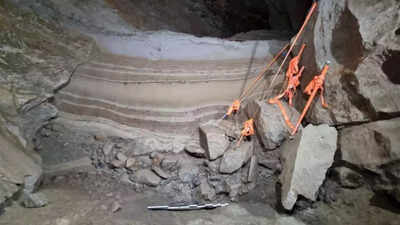A groundbreaking study published in PNAS (Proceedings of the National Academy of Sciences) in July 2025 has revealed the discovery of 75,000-year-old animal remains in Norway, preserved deep within peat bogs near Oslo. Using advanced genetic analysis and radiocarbon dating, researchers identified fragments of Ice Age megafauna, including large herbivores like reindeer and musk ox, offering rare insight into a glacial era once believed too harsh for such life. The study, titled “Ancient vertebrate DNA reveals megafaunal persistence in Late Pleistocene Norway”, provides crucial evidence that these species not only survived but adapted in northern Europe far earlier than previously assumed. It opens new doors for Ice Age research in Scandinavia and challenges long-held theories about extinction timelines and habitat resilience.
What ancient DNA uncovered in Norway’s peat bogs
Researchers extracted ancient DNA and fossilised biological traces from peat-rich sediment layers near Oslo, Norway, a region where cold, waterlogged, and low-oxygen conditions have acted like a natural deep-freeze, preserving organic material for tens of thousands of years. These layers, hidden beneath the surface, held the genetic signatures and microscopic bone fragments of large Ice Age mammals, likely including reindeer, musk oxen, or early species of horse that once roamed the region.By combining advanced genome sequencing with precise radiocarbon dating, the team confirmed that the remains dated back approximately 75,000 years. This places them firmly within the Late Pleistocene epoch, a period when northern Scandinavia was long assumed to be too harsh, cold, and ice-covered to support such megafauna.This groundbreaking find challenges previous assumptions about habitat range, migration patterns, and climate resilience of Ice Age species, revealing that these animals not only passed through the region, but may have thrived in microenvironments that remained hospitable even during glacial extremes.
How ancient DNA helped reveal a hidden Ice Age ecosystem
The DNA analysis showed genetic continuity between these ancient creatures and their later Eurasian descendants. That means these populations weren’t just surviving, they were thriving in cold glacial conditions, and some lineages may have lasted longer than once believed.This not only changes what we know about where animals lived during the Ice Age, it also redefines what kind of environments could support large mammals during extreme climate cycles.
Why ancient DNA discoveries in Norway matters
- Fills a major fossil gap in Northern Europe’s Ice Age timeline
- Reveals that megafauna survived in colder, more northern zones than expected
- Highlights peat bogs as untapped archives of ancient biodiversity
- Suggests some species had greater climate resilience than assumed
- Could eventually connect to early human migration and interaction studies
What’s next for ancient DNA research in Ice Age fossils
With this success, scientists are now expanding their research to other peatlands, frozen bogs, and tundra zones across Scandinavia and the Arctic Circle. These untouched regions could hold even more secrets from the past, preserved in ancient sediments, waiting to be uncovered. Future goals include:
- Mapping prehistoric migration corridors used by Ice Age animals
- Identifying new extinct species through advanced ancient DNA techniques
- Understanding how megafauna and smaller creatures adapted to past climate shifts over thousands of years
These insights don’t just rewrite ancient history, they help us predict how modern species might respond to today’s changing climate. In a warming world, knowing how animals once coped with extreme environmental shifts could be vital for conservation planning, habitat management, and preserving biodiversity.This isn’t just a scientific discovery, it’s a redefinition of survival. What we once assumed about extinction, movement, and endurance during the Ice Age is changing. Thanks to cutting-edge genetics and a little patience in the lab, we now know that life found a way in places previously thought too cold, too isolated, or too barren. And the next big clue? It might not be buried in some distant, icy tundra. It could be just a few feet beneath the forest floor, hidden in soil, waiting to tell the next chapter of a story that’s been frozen for over 10,000 years.Also read| New study shows how lunar soil can be turned into water, oxygen and fuel






